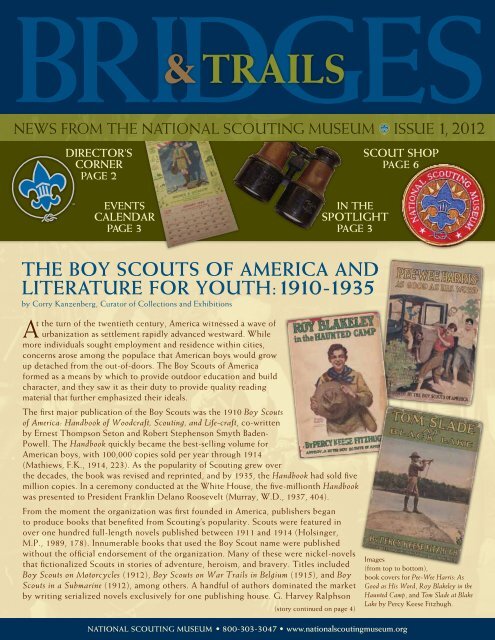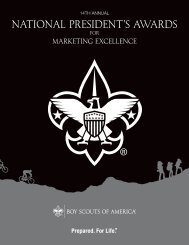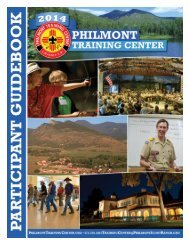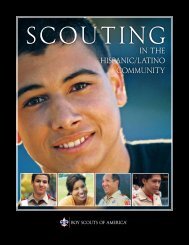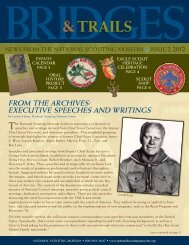The Boy ScouTS of AmericA And LiTerATure for youTh: 1910-1935
The Boy ScouTS of AmericA And LiTerATure for youTh: 1910-1935
The Boy ScouTS of AmericA And LiTerATure for youTh: 1910-1935
- No tags were found...
You also want an ePaper? Increase the reach of your titles
YUMPU automatically turns print PDFs into web optimized ePapers that Google loves.
<strong>The</strong> <strong>Boy</strong> Scouts <strong>of</strong> America and Literature <strong>for</strong> Youth: <strong>1910</strong>-<strong>1935</strong>(continued from cover)wrote twenty such books <strong>for</strong> M.A. Donahue & Company between 1911 and 1916, completing as many as five novels ina single year. Donahue also published twelve <strong>Boy</strong> Scout novels by the fictitious ”Major Archibald Lee Fletcher,” in1913, which were actually ghostwritten by Ralphson (Holsinger, M.P., 1989, 178). Between 1912 and 1919, theSaalfield Publishing Company released twenty-four titles credited to Colonel George Durston, another fictional author.This series was in fact compiled by four ghostwriters.<strong>The</strong> leadership <strong>of</strong> the organization was critical <strong>of</strong> these books, which did not embody the ideals <strong>of</strong> their brand nor thespirit <strong>of</strong> Scouting that they wished to promote. In <strong>Boy</strong> Scout’s [sic] On <strong>The</strong> Great Divide (Fletcher, A.L., 1913), <strong>for</strong>example, Scouts on a campout use revolvers to thwart <strong>of</strong>f a band <strong>of</strong> adult foes. Additionally, Scouts <strong>of</strong> the unauthorizednovels, especially Ralphson’s, disliked the outdoors and held little respect <strong>for</strong> nature ingeneral, indiscriminately killing bald eagles, bears, and other game, typically with guns.Overall, the books were undesirable to the <strong>Boy</strong> Scouts <strong>of</strong> America <strong>for</strong> their reckless andlowbrow portrayal <strong>of</strong> Scouts. But as Scouting captured the imagination <strong>of</strong> Americans, the<strong>Boy</strong> Scouts capitalized on the fiction market themselves, and used their power to influencea generation <strong>of</strong> young readers.Rather than allowing outside publishers to continue exploiting the <strong>Boy</strong> Scout image, theorganization created a Library Department to help launch the Scouts into their ownpublishing endeavors (aside from the already best-selling Handbook). In 1912, they hiredFranklin K. Mathiews, a Baptist minister, to oversee the new department and fill the role<strong>of</strong> Chief Scout Librarian. He was charged with altering the problematic image <strong>of</strong> Scoutingcreated by unauthorized books on the subject. He denounced nickel-novels on Scouting,and with limited success, encouraged booksellers and publishers to pull the titles fromtheir lists (Holsinger, M.P., 1989, 179).<strong>Boy</strong> Scout’s on the Great Divideor <strong>The</strong> Ending <strong>of</strong> the Trail, 1913In 1913, Mathiews and West began leading the <strong>Boy</strong> Scouts into new publishingenterprises, and a Library Commission was <strong>for</strong>med, comprising nationally noted librariansand academicians. In that year’s annual report, Mathiews explained, “To protect ourMovement and to help anxiously concerned parents and educators to meet the grave peril <strong>of</strong> the ‘nickel novel’ and themenace <strong>of</strong> mediocrity and viciousness found in other cheap juveniles, the Library Commission <strong>of</strong> our Movement wasorganized . . . “ (<strong>Boy</strong> Scouts <strong>of</strong> America, 1914, 61-62). <strong>The</strong> Commission was to select a series <strong>of</strong> books focused onadventure and heroism <strong>for</strong> republication under the organization’s name. Known as the Every <strong>Boy</strong>’s Library, the firsttwenty-five books in the series were issued in partnership with Grossett & Dunlap in 1913. At a cost <strong>of</strong> fifty cents pervolume, the books were intentionally inexpensive so that families could af<strong>for</strong>d them. A number <strong>of</strong> rereleased classicswere included such as Jack London’s <strong>The</strong> Call <strong>of</strong> the Wild, Kidnapped by Robert Louis Stevenson, and <strong>The</strong> Last <strong>of</strong> theMohicans by James Fenimore Cooper. Several books were published <strong>for</strong> the first time in this series, including <strong>The</strong> <strong>Boy</strong>Scouts <strong>of</strong> Black Eagle Patrol by Leslie W. Quirk. <strong>The</strong> front matter <strong>of</strong> each book included an introduction by West. In hismessage, he noted that the <strong>Boy</strong> Scouts felt obligated to nurture boys’ minds with quality literature, which augmentedtheir program <strong>of</strong> outdoor activity (West, J., 1913, v-vi).<strong>The</strong> first editions <strong>of</strong> the Every <strong>Boy</strong>’s Library sold over 71,000 copies six weeks after their initial publication (<strong>Boy</strong> Scouts<strong>of</strong> America, 1914, 62). In its second year, the Every <strong>Boy</strong>’s Library saw the sale <strong>of</strong> 175,000 books (<strong>Boy</strong> Scouts <strong>of</strong>America, 1915, 62). <strong>The</strong> <strong>Boy</strong> Scouts were the recipients <strong>of</strong> much critical acclaim <strong>for</strong> their work with children’sliterature, and Mathiews was invited to speak be<strong>for</strong>e the National Education Association and the American LibraryAssociation.<strong>The</strong> Library Department also reviewed manuscripts from outside publishers, thereby enabling them to halt theproduction <strong>of</strong> volumes that could have portrayed Scouting in a manner disagreeable to the organization. In the AnnualReport <strong>for</strong> 1914, Mathiews decried pulp nickel-novels on Scouting, or what he referred to as “<strong>The</strong> Menace <strong>of</strong> the Cheap<strong>Boy</strong> Scout Story Books” (<strong>Boy</strong> Scouts <strong>of</strong> America, 1915, 63). His impassioned writing provided outlandish andunverifiable examples <strong>of</strong> the ways in which publishers commissioned and marketed these unauthorized books onScouting. He claimed that one author <strong>of</strong> a popular <strong>Boy</strong> Scout series was committed to an asylum <strong>for</strong> the insane, anotherwrote books under the guise <strong>of</strong> twelve different names, and still others authored twenty-five to fifty cheap books in asingle calendar year. Much to Mathiew’s dismay, even a press agent <strong>for</strong> Buffalo Bill’s Wild West Show was alleged to(story continued on page 5)4
<strong>The</strong> <strong>Boy</strong> Scouts <strong>of</strong> America and Literature <strong>for</strong> Youth: <strong>1910</strong>-<strong>1935</strong>(continued from page 4)have written pulp novels on Scouting. In response, the price<strong>of</strong> Every <strong>Boy</strong>’s Library books was dropped from fifty totwenty-five cents per novel, in order to directly contendwith the prices <strong>of</strong> newly bound volumes <strong>of</strong> unauthorizedScout literature (<strong>Boy</strong> Scouts <strong>of</strong> America, 1915, 59-64).By 1916 the Library Department was considered an integralpart <strong>of</strong> the organization as a whole. Ten additional titleswere added to the Every <strong>Boy</strong>’s Library, and total sales <strong>for</strong>the books numbered 268,748 over two and a half years(<strong>Boy</strong> Scouts <strong>of</strong> America, 1916, 64). Using the Scout-ownedmagazine, <strong>Boy</strong>s’ Life, as another venue from which topromote their mission, the Library Department beganregularly contributing as many as fifty book reviews perissue. This allowed Mathiews and his team to gain furthercontrol over the books that were marketed to Scouts, as<strong>Boy</strong>s’ Life circulation reached 100,000 subscribers by 1917,and continued to grow significantly in the years that followed.Toward the end <strong>of</strong> 1915, the Library Commission hired authors who could produce new serialized books onScouting under their auspices. Percy K. Fitzhugh’s Scouting Along the Mohawk Trail (1913) found success with its initialpublication in the Every <strong>Boy</strong>’s Library, and subsequently Mathiews invited the established journalist and author <strong>of</strong>children’s literature to write a series <strong>of</strong> fictional Scout books. <strong>The</strong>se became known as the Tom Slade series, <strong>of</strong> whichnineteen novels were produced. <strong>The</strong> character <strong>of</strong> Slade, a poor boy from Bridgeboro, New Jersey, was cast as aHuckleberry Finn type, whose life was changed by Scouting. Frequently finding himself in trouble, Slade is saved ineach novel by falling back on his commitment to the Scouting program. So well-liked was the series that it stoodsecond in popularity only to the Tom Swift series by Victor Appleton (Holsinger, M.P., 1989, 180). Sales <strong>of</strong> the bookshelped to curb the prevalence <strong>of</strong> nickel-novels and other “trashy books” (<strong>Boy</strong> Scouts <strong>of</strong> America, 1919, 118) deemedunsuitable <strong>for</strong> youth by Mathiews and his team. In light <strong>of</strong> the broad success <strong>of</strong> the Tom Slade series, Fitzhugh authoredadditional Scouting novels. In 1920, the first books from Fitzhugh’s Roy Blakeley series were published. In 1922, heintroduced the Pee-Wee Harris series, which would grow to fourteen novels. To this day, Harris is still familiar toScouters through a popular monthly comic strip featured in <strong>Boy</strong>s’ Life magazine.In addition to the Every <strong>Boy</strong>’s Library and other initiatives, the <strong>Boy</strong> Scouts endorsed fiction that they viewed asworthwhile literature <strong>for</strong> children, citing the pressing need <strong>for</strong> quality juvenile fiction in America. <strong>The</strong> LibraryDepartment also provided booklists to parents and schools. In 1915, the Library Department introduced the firstnational book week. This was initially known as “Safety First Juvenile Book Week,” then “Good Book Week,” followedlater by “Children’s Book Week” (Murray, W.D., 1937, 404). <strong>The</strong> <strong>Boy</strong> Scouts partnered with the American LibraryAssociation and the Parent Teachers Association to launch this annual reading program in order to promote qualityliterature <strong>for</strong> youth, and it is still celebrated each year.During the Great Depression, the <strong>Boy</strong> Scouts lost ground in the publishing business, as the collapse <strong>of</strong> Wall Streetparalyzed the book market generally (Holsinger, M.P., 1989, 181). When the novelty <strong>of</strong> Scouting itself waned after itsfirst two decades in America, so too did the novelty <strong>of</strong> fictional <strong>Boy</strong> Scout tales. <strong>The</strong> Chief Scout Librarian remained afixture at the organization through <strong>1935</strong>; Mathiews used his role to influence the motion picture industry and promotereading among youth by partnering with libraries and schools (<strong>Boy</strong> Scouts <strong>of</strong> America, 1930, 186-187). That same year,the Library Department was replaced by a Reading Program Service, whose central purpose was to develop annual lists<strong>of</strong> literature deemed worthwhile <strong>for</strong> children (Murray, W.D., 1937, 406).So successful were books on Scouting that millions <strong>of</strong> authorized and unauthorized publications alike were circulatedamong American boys between <strong>1910</strong> and <strong>1935</strong>. <strong>The</strong> influence <strong>of</strong> the <strong>Boy</strong> Scouts <strong>of</strong> America on children’s literaturecannot be underestimated during the early years <strong>of</strong> the twentieth century. From the phenomenal success <strong>of</strong> the <strong>Boy</strong>Scout Handbook to the fictional literature produced and endorsed by a focused and determined Library Department, thesheer volume <strong>of</strong> their output in this realm is impressive.(references on page 8)President Franklin Delano Roosevelt Receiving BSA Handbook, <strong>1935</strong>5
THE NATIONAL SCOUTING MUSEUMSCOUT SHOP<strong>The</strong> museum Scout shop features a wide assortment <strong>of</strong> gifts,mementos, and collectibles, as well as Scouting essentials.To order NSM exclusive items online, visit the Scout shoppage at www.nationalscoutingmuseum.org.AB100 BuzzballItem# 610101$3.48NSM Crystal PaperweightItem# 520546$27.95New Item!!!<strong>Boy</strong> ScoutsOf America ®Scout Stuff BookItem# 613201$29.99NSM EmbroideredEmblemItem# 610851$2.99NSM Hacky Sack(multicolor)Item# 610663$2.86ORDER FORMNameAddressCity State Zip Country Postal CodeEmailTelephonePayment Method (check one) CHECK/MONEY ORDER AMERICAN EXPRESS VISA MASTERCARD DISCOVERCard NumberNSM Key Ring LightItem# 610662$2.50DateExpiration DateNSM Photo EmblemItem# 610852$1.29Item Description Item Number Price Each Quantity Total PriceDomestic Shipping Charges - GROUNDOrder Amount AddUp to $50 $7.50$50.01 to $100 $9.95$100.01 to $150 $13.50$150.01 or more 9% <strong>of</strong> total orderInternational shipping chargesOrder Amount AddUp to $50 $25$50.01 to $100 $35$100.01 to $200 $45$200.01 or more 25% <strong>of</strong> total orderSubtotalshipping & handlingTAX 8.25%TOTALMail order <strong>for</strong>m to National Scouting Museum Scout Shop, P.O. Box 152079, SUM 505, Irving, TX 75015-2079, or fax to 972-580-7875.Call the National Scouting Museum Scout Shop at 972-580-2484 <strong>for</strong> more in<strong>for</strong>mation.Please note: Orders take up to six weeks to complete. Prices are effective January 1, 2012, through December 31, 2012, and are subject tochange without notice. Retain a copy <strong>for</strong> your records. To expedite shipping, call the National Scouting Museum Scout Shop at 972-580-2484.6
NSM OrnamentItem# 612991$9.99NSM Playing CardsItem# 610658$8.57NSM Salt & Pepper ShakersItem# 520603$12.95NSM Golf BallItem# 520617$2.95NSM CapItem# 612990$14.99Wooden Pick UpSticksItem# 520788$8.00NSM Pen & Pencil Set,with caseItem# 520616$34.95NSM Cub ScoutBelt LoopItem# 613024$1.79NSM Traveler Tumbler(purple, silver, or red)Item# 610664$15.95NSM Hiking StaffMedallionItem# 613063$4.99NSM MagnetItem# 613062$6.99NSM Toothpick HolderItem# 610660$4.99NSM Mouse PadItem# 610659$6.94NSM T-Shirt(Youth S – Adult XL)$8.99-11.99NSM Belt BuckleItem# 613117$14.99Vintage Game Tin —Fish PondItem# 520781$9.00NSM Stress Ball(black, green, red, pink, or blue)Item# 610661$3.75NSM Carabiner with Keychain(blue, red, green, orange, or silver)Item# 613118$1.29NSM Wristband(red, yellow, orange, or purple)Item# 520779$1.25MORE GREAT NSM ITEMSITEM ITEM# PRICEBADEN-POWELL: <strong>The</strong> Two Lives <strong>of</strong> a Hero 340990 $45.99by William Hillcourt with Olave, Lady Baden-Powell (not pictured)NSM Blue Optic Mug (not pictured) 612909 $6.99NSM Black Cap (not pictured) 612990 $14.99NSM Window Cling (not pictured) 612932 $2.99NSM Domed Sticker (not pictured) 612933 $3.99Vintage Game Tin —Mountain ClimbItem# 520784$13.007
<strong>Boy</strong> Scouts <strong>of</strong> AmericaNational Scouting Museum1329 West Walnut Hill LaneIrving, Texas 75038Non-Pr<strong>of</strong>it Org.U.S. PostagePAIDIrving, TXPermit No. 616<strong>The</strong> <strong>Boy</strong> Scouts <strong>of</strong> America and Literature <strong>for</strong> Youth: <strong>1910</strong>-<strong>1935</strong>(continued from page 5)References<strong>Boy</strong> Scouts <strong>of</strong> America. (1915). Fifth Annual Report <strong>of</strong> the <strong>Boy</strong> Scouts <strong>of</strong> America. New York, New York: <strong>Boy</strong> Scouts <strong>of</strong>America.<strong>Boy</strong> Scouts <strong>of</strong> America. (1914). Fourth Annual Report <strong>of</strong> the <strong>Boy</strong> Scouts <strong>of</strong> America. New York, New York: <strong>Boy</strong> Scouts <strong>of</strong>America.<strong>Boy</strong> Scouts <strong>of</strong> America. (1919). Ninth Annual Report <strong>of</strong> the <strong>Boy</strong> Scouts <strong>of</strong> America. New York, New York: <strong>Boy</strong> Scouts <strong>of</strong>America.<strong>Boy</strong> Scouts <strong>of</strong> America. (1916). Sixth Annual Report <strong>of</strong> the <strong>Boy</strong> Scouts <strong>of</strong> America. New York, New York: <strong>Boy</strong> Scouts <strong>of</strong>America.<strong>Boy</strong> Scouts <strong>of</strong> America. (1930). Twenty-First Annual Report <strong>of</strong> the <strong>Boy</strong> Scouts <strong>of</strong> America. Washington, D.C.:Government Printing Office.Fletcher, A.L. (1913). <strong>Boy</strong> Scouts on the Great Divide, or, <strong>The</strong> Ending <strong>of</strong> the Trail. Chicago: M.A. Donahue & Company.Holsinger, M.P. (1989). A bully bunch <strong>of</strong> books: <strong>Boy</strong> Scout series books in American youth fiction, <strong>1910</strong>-1930.Children’s Literature Association Quarterly 14(4), 178-182. Retrieved from Project MUSE database.Mathiews, F.K. (Ed.). (1921). <strong>The</strong> <strong>Boy</strong> Scouts Year Book: Stories <strong>of</strong> Brave <strong>Boy</strong>s and Fearless Men. New York:D. Appleton-Century Company.Mathiews, F.K. (1914). <strong>The</strong> Influence <strong>of</strong> the <strong>Boy</strong> Scout Movement in Directing the Reading <strong>of</strong> <strong>Boy</strong>s. In Bulletin <strong>of</strong> theAmerican Library Association. 8(1), pp. 223 -228. Retrieved from Google Books.Murray, W.D. (1937). <strong>The</strong> History <strong>of</strong> the <strong>Boy</strong> Scouts <strong>of</strong> America. New York: <strong>Boy</strong> Scouts <strong>of</strong> America.West, J. (1913, July 1). Foreword. In Tomlinson, E.T., Scouting with Daniel Boone (pp. v-vi). New York: Grosset &Dunlap.


